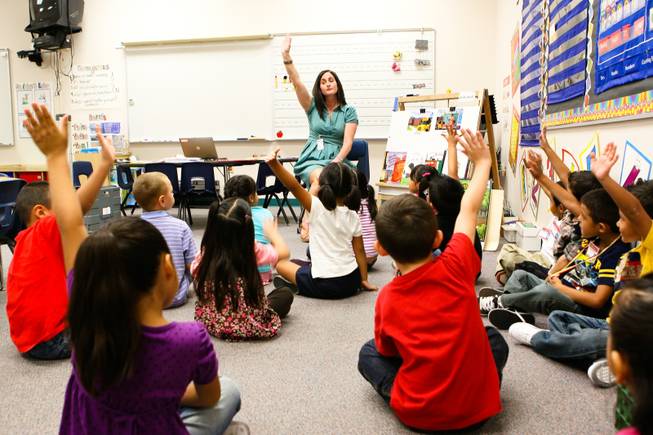
Mona Shield Payne
Kindergarten teacher Julie Cohen teaches her students how to ask questions with a raise of hands on their first day of class Monday, August 27, 2012, at Cambeiro Elementary School in Las Vegas.
Thursday, May 16, 2013 | 11:42 a.m.
About the Nevada Kindergarten Survey:
- Last fall, UNLV researchers distributed nearly 25,000 surveys to families in all 17 school districts in Nevada. They received surveys from nearly 8,500 families, which represented a 35 percent response rate.
- The majority of the survey respondents — 60 percent — were from Clark County, which is not surprising because about two-thirds of the state’s population lives in Southern Nevada. Clark County’s results were not that much different from the state results.
- The Clark County School District has participated in the study since its inception. In the first year, questionnaires were distributed to all the elementary schools in the district, but in the past two years, researchers used a stratified random sample of about 140 schools to calculate its results.
More Nevada children are entering kindergarten without health insurance and face greater barriers to health care access, according to an UNLV report released Thursday.
For the past five years, researchers at UNLV’s Nevada Institute for Children’s Research and Policy surveyed thousands of families across the state, seeking demographic and health information of children entering kindergarten.
This year, UNLV researchers found about 14 percent of survey respondents said their kindergartener did not have health insurance. This represents a 5.6 percentage point increase since the survey began in 2008 – when the recession started.
The survey also found uninsured children were most likely to come from Hispanic or caucasian households making less than $35,000 a year.
Nevada has consistently ranked near the bottom of national rankings when it comes to the number of children covered by health insurance, according to the UNLV report. A 2011 U.S. Census Bureau study found that Nevada had more than double the number of uninsured children than the national average of 7.5 percent.
This is troubling because research shows that uninsured children are more likely to be unhealthy than children who are insured. The UNLV report illuminates the challenges Nevada faces in ensuring its residents comply with the federal Affordable Care Act, which will be fully in effect in 2014.
In the aftermath of the Great Recession, more families stated that a lack of financial resources was a barrier to health care access, according to the UNLV report.
About 15 percent of families reported a lack of money was a barrier to accessing health care. This is an increase of 13 percent from the previous year.
Although more children are seeing a primary care doctor before entering kindergarten, uninsured children are less likely to have a primary care doctor, according to the UNLV report.
Just 42 percent of uninsured children have a pediatrician, while nearly 90 percent of children with health insurance have a pediatrician.
Despite these financial challenges, the UNLV report found some positive health trends occurring among Nevada kindergarteners.
About 30 percent of Nevada kindergarteners are overweight or obese, a nearly 8 percent drop since the survey began in 2008. Nevada children are also watching less television, drinking less soda and engaging in more physical activity than a year ago, according to the report.
The 28 questions on the Nevada Kindergarten Health Survey hit upon a variety of health issues, including a child's health insurance status, frequency of routine health care, immunizations, access to care, weight status and healthy behaviors.
The survey information will be helpful for state leaders making funding and policy decisions impacting Nevada's youngest citizens, said Tara Phebus, the institute’s associate director.
"This information is useful for policy-makers as they make decisions relating to the health of our youngest children," Phebus, one of the study's co-authors, said. "It's important to look at where our kids are in this state in order to make decisions, especially when making cuts or reallocations."
Other Findings in UNLV Survey
- Here are some of the other major findings of the UNLV report:
- • About 15 percent of children are underweight; about 30 percent are either overweight or obese
- • About 80 percent of children watched two hours or less of television each day
- • About 89 percent watch or play equal to or less than one hour of computer or video games per school day
- • About 34 percent come from a family where the household income is less than $25,000 per year, an increase of 4 percent.
- • About 30 percent had public health insurance, such as Medicaid or Nevada Check-Up.
- • About 14 percent were uninsured, a 10 percent increase in uninsured from last year.
- • About 86 percent had at least one routine check-up within the past year.
- • About 83 percent had a primary care provider, a 1 percent decline from last year.
- • About 75 percent had received routine dental care in the past year, a 2 percent increase since last year.

Join the Discussion:
Check this out for a full explanation of our conversion to the LiveFyre commenting system and instructions on how to sign up for an account.
Full comments policy